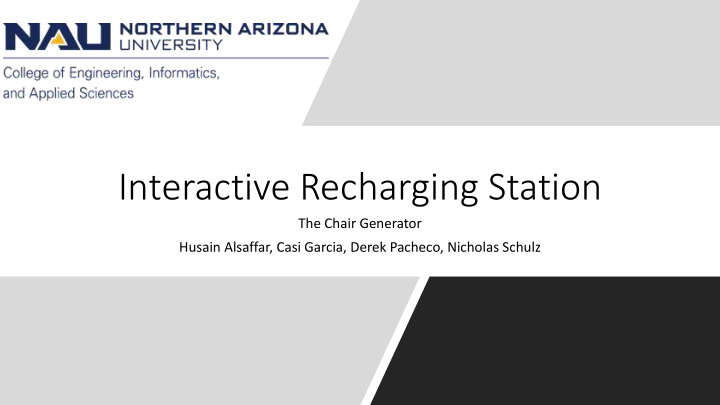



Interactive Recharging Station The Chair Generator Husain Alsaffar, Casi Garcia, Derek Pacheco, Nicholas Schulz
Project Description Project Goal: • Design and build a mobile device recharging station that is interactive, educational and enjoyable for all users utilizing its capabilities. • Build design within a supplied budget of $2000. Stakeholders/Beneficiaries: • Dr. Sarah Oman • Ms. Kayla Goodrich • Northern Arizona University Engineering Building, Present & Future: • Students • Faculty • Visitors 04/26/19 Casi Garcia
Background NAU Eco-Peddler (Yellow Bike) • Previous NAU capstone project. • Funded by the NAU Green Fund. • Has had 3 iterations generated in the last 10 years. Figure 1. Yellow Bike. 04/26/19 Casi Garcia
Background Cont. Is the Eco-peddler being used? Why not? • Awkward (52) • Inefficient (Doesn’t Charge Phone) (15) • Boring (12) • Too Demanding (9) • "Bad Advertising"(10+) 04/26/19 Casi Garcia
Requirements Table 1. Engineering Requirements and Target Values. Customer Requirements Engineering • Portable Requirements Target Value • Easy Disassembly Max. Weight < 100 lbs. • Recharge Capabilities Dimensions < 36x36x72 in. • Educational = 5 Volts • Audience Comfort Power Generation > 0.25 Amp. • Durable Engineering Principles > 1 principle Noise ≤ 75 db. Max. Force ≤ 275 lbs. 04/26/19 Husain Alsaffar
Design Process: Selected Design Chair Generator (Chair Gen.) • Users use swiveling action in an office chair to generate electricity • Selected for comfortability and ease of use • Initial Concept • Custom alternator mounted to chair shaft • Electrical ports, cables and converters to be housed in electrical box mounted to side of the chair Figure 2. Original Concept. 04/26/19 Husain Alsaffar
Design Process: Revisions Revision 2: Gearbox Design Revision 3: Pulley Design • • Eliminated need for custom alternator. Less complicated than gearbox. • • Generated higher RPM input to generator. Less torque required than gearbox. • In safer position than gearbox. Figure 3. Revision 2. Figure 4. Revision 3. 04/26/19 Nicholas Schulz
Final Design Sprocket Design • 1:6 Ratio. • Internally Routed Cables. Figure 5. Final Design. 04/26/19 Nicholas Schulz
Manufacturing Figure 6. Manufacturing the Design. 04/26/19 Derek Pacheco
Manufacturing: Chair Shaft Base Wheels Tapered Roller Bearings 3” Rubber Wheels Hollow, Aluminum, Non-adjustable Figure 9. Added Wheels. Figure 8. Bearings Press Fit into Chair Base. Figure 7. FEA of Shaft vs. Actual Shaft. 04/26/19 Derek Pacheco
Manufacturing: Generator Base Sprockets Generator Base Generator 6:1 Ratio Waterjet by MarZee Inc. 5V-24V Mini Wind Turbine Generator Figure 11. Generator Base Plate. Figure 12. Generator. Figure 10. Sprockets and Chain. 04/26/19 Casi Garcia
Manufacturing: Electrical Box Electrical Housing Electrical Base Electrical Wiring Waterjet by MarZee Inc. Pass-Through Charging Battery, Generator Electrical Wiring, Switch Rectifier 100 µF Capacitor Voltage Regulator 22 µF Capacitor Figure 14. Electrical Base Plate. Switch LED Screen Figure 13. Electrical Box. 04/26/19 Nicholas Schulz
Manufacturing: Electrical Schematic Figure 15a. Electrical Box. Figure 15b. Electrical Box Schematic. 04/26/19 Nicholas Schulz
Final Assembly Figure 16. Manufactured Design. 04/26/19 Husain Alsaffar
Testing: Results Table 2. Engineering Requirements, Target vs Actual Values. Engineering Pass/ Requirements Target Value Actual Value Fail Max. Weight < 100 lbs. ~ 45 lbs. Pass Dimensions < 36x36x72 in. 28x34x38 in. Pass = 5 Volts 5 Volts Pass Power Generation > 0.25 Amp. 0.71 Amp. Pass Engineering > 1 principle 4 principles Pass Principles Noise ≤ 75 db. 68.9 db. Pass Max. Force ≤ 275 lbs. 277.1 lbs. Pass 04/26/19 Husain Alsaffar
Testing: Methods Portability: Durability: Hold ≤ 275 lbs. Weigh ≤ 100 lbs. Dimensions ≤ 3x3x6 ft. (95% of Adult Men) Figure 18. Weight Test. Figure 19. Size Test. Figure 17. Durability Test. 04/26/19 Derek Pacheco
Testing: Methods Cont. Quietness: Reliability: Educational: Noise ≤ 75 db. Outputs ≥ 5V Engineering Principles ≥ 1 Spinning ≥ 10 RPM Human Energy Rotational Energy Mechanical Energy Electrical Energy Figure 21. Reliability Test. Figure 20. Noise Test. 04/26/19 Derek Pacheco
Special Thanks! • Dr. Sarah Oman, Mechanical Engineering Department • Ms. Kayla Goodrich, Honeywell • Professor John Sharber, Electrical Engineering Department • NAU Machine Shop 04/26/19 Husain Alsaffar
Questions?
Recommend
More recommend